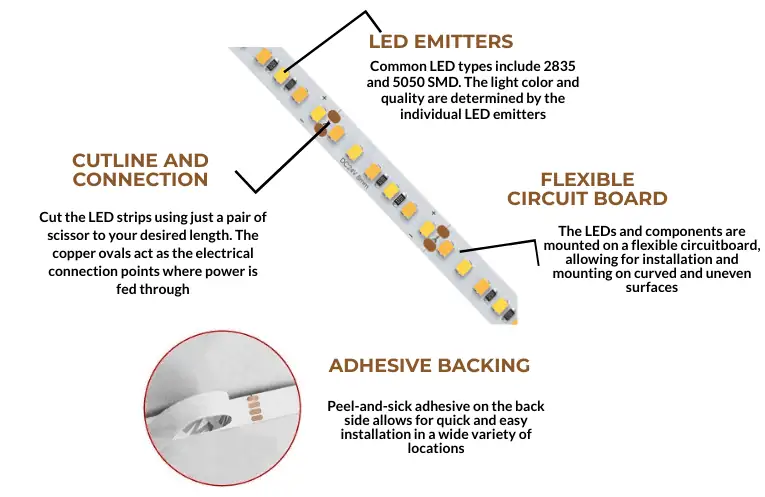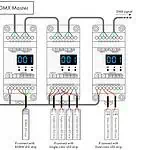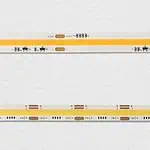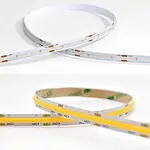A flexible circuit board that is designed with LEDs is the LED strips. Sticking these strips to enlighten the dull corners of a spot can be a great idea. The audience can efficiently acquire these LED strips concerning the brightness and lighting capacity.
This particular lighting element can be twisted up to 90 spans. However, you can cut down the LED strike effortlessly after looking into every inch of the working space. Several color-changing or single-color options are available under this category. The strips are stuck with 3M tape attached to the back. Moreover, sometimes adhesives are also preferred for this method.
The content segments will clear out the audience’s vision about LED strips and walls. As the reader proceeds with it, he will learn what types of walls are not preferred for LED strips or how he can take off the strip without damaging the wall’s surface. Additionally, a few more interesting query-resolving sections are also there.
Will LED Strips Damage My Walls?
Do LED strips damage walls or wall paints? It’s one of the most controversial questions. A community of audience must respond to it positively, whereas some in negative terms. However, the adhesive used in the LED strip lights can efficiently answer this question.
Generally, these strips couldn’t deteriorate the condition of the wall. Still, you can make this condition after looking into certain factors associated with the wall surface and the LED strips. The adhesive used in sticking the strips in the wall is likely to take off or damage the paint because of the adhesive’s strength on the strips’ surface.
Alternatively, the durability of the wall and the materials used during construction also play a strong character in this context. Cheap quality materials tend to work negatively after using adhesives on the will for sticking LED strips.
However, if someone wants to remove these strips, working carefully with heat sources is essential. The gentle heat produced will initiate the removal of the LED strips quickly without any extra effort.
LED Strip Material Details
The LED strips appeared like tape, called LED ribbon or LED tape. There are a lot of ingredients that togetherly assemble the entire look of the LED strips. FPCB/ALUMINUM PCB/FR-4/CME-3, silicon tube, 3M tape, PVC material, silicon glue, and lead chips are its fundamental components.
The connectors of the LED strips for single color are composed of 2-pin connectors, which work with at least 20-22 Gauge stranded wire. Whereas for multicolor ones, 4-pin LED strip connectors are required. Generally, 18 gauge LED wire is preferred for connecting 24V LED strips.

Type Of Walls Vulnerable To LED Strips
Presently, different types of walls are preferred for LED strips and are not suitable for adhering to these strips. If the walls are tiled, plastic, or have a wooden finished appearance, then it’s entirely acceptable to establish the similitude between walls and LED stripes.
However, you can easily put the likeness or the fondness forward because you can remove those strips quickly without staining or causing any damage. Conversely, if any leftover adhesive can be glimpsed on the wall, it can be smoothly wiped off.
But you couldn’t manage this procedure if the wallpaper was coated with paint or ordinary bare drywall. These types of walls are made of fragile materials that can readily get damaged with adhesives.
The unpainted or unprimed walls are the bare drywalls. Any protective coating does not cover the outer layer of the wall, so it tends to fall off easily. In this kind of wall, patches are readily formed if the adhesives are used to clamp the LED stripes.
With the advancement of the realm, the decorative concepts of walls are clinging wallpapers on it to provide a distinctive dimension to the walls. Sticking LED strips on this type of wall is not a good idea, as the wallpaper can come off after using adhesive or any other glue.
How Are LED Strips Installed On Walls- The Right Method
Before installing the LED strips, it’s vital to jot down the required tool. Some essential tools for this procedure are measuring tape, wet cloth, adhesive, and scissors. If the strips are installed ceiling, the ladder is one of the most significant pieces of equipment.
The stages of the installation process are:
- Choosing the correct surface
Before considering or choosing LED strips as a new decor for a specific corner, it’s essential to look at the wall’s surface. There are better options than a painted wall for the installation of this item. In comparison, a smooth surface is mainly preferred.
After choosing the surface, it comes selecting the location of attaching the strips. Above the cabinets, the margin of the kitchen, gaming rooms, or behind the television are key points.
If someone is considering incorporating the idea of LED strips in the ceiling, it’s better to use wireless light strips to provide a clean and fresh look; wireless strips are evaluated.
- Measurement of the surface before installation
After choosing the area for the strip setup, it’s time to figure out the exact measure of that specific place. The correct measurement will prompt the adjustment of the strips concerning the length.
- Adjustment of the strip
After knowing the room’s length, it’s feasible to figure out the exact strip size required for the particular place. On the other hand, this will lower the purchasing amount by just buying the precise scope of the strip.
However, strip extensions can also be an alternative. It’s better to avoid connecting the strips at a 90° angle, especially around the television, to provide a round look with the strip; it’s exemplary to utilize flexible connectors.
Moreover, you can also trim the strips according to the length of the exterior. On the surface of the strip, some specific markings are made from where you can cut them without damaging the lighting circuits to avoid any accident, and it’s essential to unplug the LED strip before shortening it.
- Cleaning the surface
After cutting the strips according to the length, it’s ready to proceed towards the adhesion procedure. Before sticking, the surface needs to be cleaned with a moist cloth. Mopping the surface is essential to remove any kind of oil or dirt present on the surface.
- Placement of the LED strip
Before placing the strip into its place, the installer should be conscientious. Adhesive can easily damage the surface, so it’s crucial to prominently figure out the attaching place. However, people are inclined to use double-sided adhesive to avoid such damage.
Once the surface is cleaned, the user can install the strip after peeling the adhesive sticker from the back. However, pressing the strips against the surface for 10-15 seconds is essential. Nonetheless, you should follow this hold and press method for every six inches of the LED strip.
How To Remove LED Strips Safely- The Right Method
Before stepping into removing the strips from the wall surface, it’s better to look into specific steps which you can ascertain are beneficial for everyone.
- Unplugging the LED
Before commencing the peeling procedure, putting off or implying the LEDs is essential. Playing with electricity is not a good idea. Turning off the power source at the beginning of the work is crucial to avoid any accidents.
- Heating the adhesive
The LED strips are attached to the wall with higher-strength adhesives. This kind of adhesive can easily take off the paint or the surface material of the wall. At the initial stage, the adhesive layer should be heated with the help of a hairdryer. The incorporation of extreme heat will soften the surface of the adhesive attached to the strip and quickly come out.
On the other hand, heating the adhesive for a prolonged period can instigate the lumen degradation of the strips. So providing heat for a couple of minutes will be enough to warm up the glue.
- Start peeling from the end
Never try to keep the strip from the middle. Always try to peel it off from the extreme corner. However, there are better ideas than using a sharp-end object while peeling. It’s better to keep a flat thing at the button of the strip for a predominant procedure.
- Application of gentle motion
For peeling the strips, it’s vital to lay on a gentle motion for pulling them in sections. Moreover, working slowly until the LED strip comes out entirely is crucial. Peeling off the strip too quickly can damage the internal wires. Applying gentle pressure and motion to remove the strip is a time-consuming procedure.
- Drying the strips
After removing the entire strip from the wall surface, it’s essential to dry it out. Moreover, the leftover adhesive should be dried out before reusing or keeping the strip.
- Working with the leftover adhesive
If the leftover adhesive is attached to the wall, then to take it off gently, try to rub it with your thumb. The glue will eventually come out with the application of minimal pressure.
If this trick works efficiently on the tacky adhesive, try putting either citrus-based cleaner or WD-40 on the surface. After the application, rub the exterior in a circular motion to remove the entire glue.
Tips For Securing LED Strip Lights
If you’re planning on installing LED strip lights on your wall or furniture, below are a few tips and suggestions for an effective installation.
Preparing The Surface
If installing on surfaces such as above the cabinets or tight corners, consider wiping off dust with a dry rag. Following that, please rub the installation surface with a wet rag, followed by a dry rag again. This’ll remove dust completely from the installation surface, resulting in a well-stuck LED strip.
Don’t Hesitate To Back Your Strip With Sellotape
If you’re looking for a long-lasting LED strip, please consider adding a layer of sellotape or any clear self-adhesive tape to the LED strip. Once you’ve finished the installation, adding an extra layer of self-adhesive tape will help keep the LED strip stuck to the installation surface for a long time.
Consider Using Adhesive If Needed
Sometimes, old stock of LED strips in the shops results in the poor sticking ability of the adhesive. While old stock doesn’t affect LEDs’ output, the adhesive still has a low shelf life. If you observe low sticking nature of the adhesive, consider applying a layer of adhesive from the market on the LED strip before installation. This’ll help you recover the loss of adherence power in old LED strip lights.
Double-sided Tape Is A Good Option
You can use double-sided tape to secure your LED strip on the wall for a long time. Double-sided tapes are available in various formats, such as rubberized double-sided tapes, double-sided cloth tapes, etc. Double-sided tapes have a strong adhesive that can hold your strip in place for a long time. But if your wall putty is peeling, worn out, or damaged from moisture, never use double-sided tape there.
FAQs
LEDs can damage the paint. That’s why several unique types of lights have been put forward with advanced technology to avoid such a situation. The direction of light is controlled by changing the angle of the beams.
The audience must have noticed that the area around the LED lights turns black with time because of the emission of the bright beams of the lighting source. This results in damaging the paint around the lighting fixtures. Hence, LED lights can damage the paint.
The damaging effect of LED strip lights depends upon several factors. However, the durability of the wall, strong adhesive, and climate are the main factors when it comes to damaging the paint. Moreover, latex paint works efficiently on painted walls and doesn’t cause any deterioration.
If someone wants to remove the strips from the wall, working patiently after applying gentle heat is essential. Gentle motion and pressure with lots of patience are required to remove the LED strip properly so that a minimal portion of paint comes from the surface.
Yes, it’s very straightforward to reuse the LED strip removed from a wall. This kind of lighting source is different from the permanent light illuminated. Moreover, the strip’s brightness or intensity won’t be hampered after its removal and the attachment method to another surface.
Moreover, after removal, it’s essential to remove the leftover adhesive from the strip. Adding more sealant on the spare part will work better. As a result, the strip won’t stick properly on the surface.
Whether LED lights are safe on walls depends upon the materials used to build their surface, considering their durability and the climate. On the other hand, sticking this lighting fixture on the border with adhesive can come forward as one of the damaging elements.
However, double-sided tapes are preferred to overlook such a situation so that the wall paint won’t come out. The paint’s quality and the wall’s durability determine efficiently how double-sided tapes will take off the paint or not.
Instead of using adhesive to stick the LED strips, you can consider hot glue. Hot glue will quickly stick the strips into the surface without damaging the wall paint. However, this happens because this glue doesn’t contain any strong chemicals that affect the paint’s consistency.
On the other hand, several advanced pieces of equipment have been introduced to take care of the wall paint. Generally, people also avoid using nails to hang the strips. For them, damage-free adhesive hooks, drawing pins, wire suckers, and many more can be some of the best options to turn the LED strips without hampering the paint.
Yes, LED lights can fade the wall paint. LED lights tend to emit high photon energy, which can trap the volatile compounds in the LED’s lens, which leads to discoloration.
The audiences are much fond of this type of light as it can easily overpower energy consumption and hence lowers the payment of electric bills. But nobody has a clear vision of LED fading paints. The volatile compounds in the environment, in association with UV radiation and other phases, instigate LED lights to do so.
The audience can secure their LED strip lights on the wall by adding strong adhesive on the back of the strips. Double-sided tapes or hot glue can be great options if someone wants to avoid adhesive.
However, some prefer using hooks or other equipment to secure LED strips. For them, hooks, drawing pins, and wire suckers are the preferable ones. However, double-sided tapes or hot glue provide a clean look to the entire surface where the LED strip light is attached.
Tapes are used to secure LED lights but not the normal ones. People who avoid adhesives or hooks use double-sided tapes to stick the strip on the surface—choosing this type of tape to ensure a damage-free wall surface.
Adhesives are made up of harsh chemicals, which can quickly affect the wall paint. However, to overlook this situation, double-sided tapes are used. They can securely hold the strips on the surface, excluding any risk factor. On the other hand, you can efficiently remove it from the surface.
People who don’t want to use nails for sticking the lights mainly prefer hooks or double-sided tapes. Generally, adhesives are used to adhere to the strips. But the chemical used in the adhesive causes damage to the wall surface. So most of the audience avoids sticking the LED light strips with achieves.
As an alternative, the adhesive double-sides are used, which don’t cause any deterioration to the surface. On the other hand, it gives a clean look to the wall.
If the LED strips are attached to the wall surface with solid adhesive, then it’s a high chance that the paint will come out during the removal of the strip. That’s why people should give gentle pressure and motion while removing it.
However, the chipping of paint also depends upon the durability of the wall and the climate. So now, people generally prefer double-sided tapes to stick to the strip to prevent paint chipping.
LED lights don’t take off the paint. It can fade away the paint around the light fixture. However, tearing the paint off depends upon the surface durability, the adhesive used, and the climate.
The material used to make the surface also plays a crucial role in this section. If someone is going with LED lights, it’s highly preferable to opt for latex paint as it doesn’t tear off.
Sticking LED strips on walls is a small deal at present. Several adhesives and other equipment introduced can easily allow the sticking of strips. Hooks, nails, adhesives, hot glue, or double-sided tapes are used according to the user for sticking the LED light strips into the wall surface.
Conclusion
LED strips create an innovative and enlightening proportion to the attached surface. At present distinctive types of strips have appeared in the market, which is generally preferred. Along with providing an aesthetic look, the audience always worries about quickly pulling it off.
The above-illustrated segments of this content are about the types of surfaces that are unsuitable for the LED strips. A brief section is also adjoined about the steps to skillfully peel off the strips and the adhesive residue from the surface. In contrast, the button section of the context explains several crucial questions about LED strips that are essential to go through before considering them.
LEDYi manufactures high-quality LED strips and LED neon flex. All of our products go through high-tech laboratories to ensure the utmost quality. Besides, we offer customizable options on our LED strips and neon flex. So, for premium LED strip and LED neon flex, contact LEDYi ASAP!


